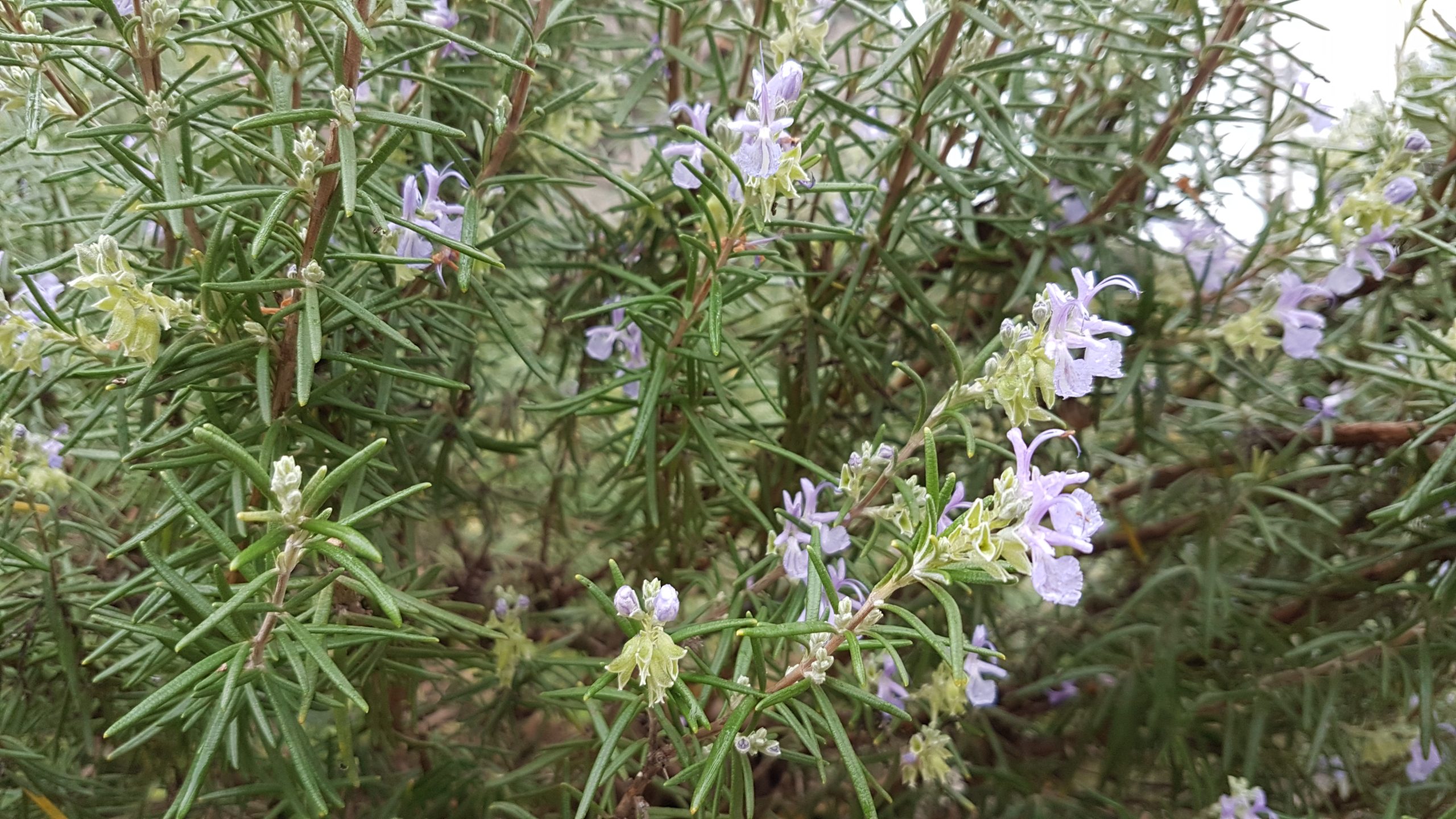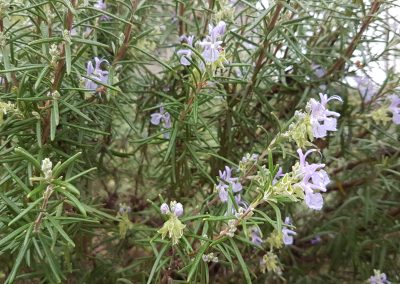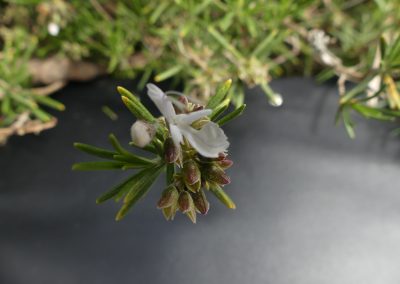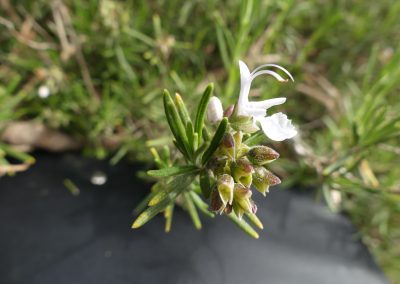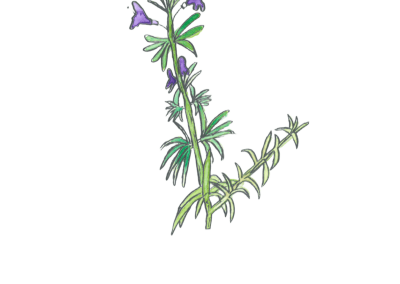Rosmarinus officinalis
Scientific description
Taxon: Rosmarinus officinalis
Class: Eudicotyledons
Subclass: Asterids
Order: Lamiales
Family: Lamiaceae
Common name: Rosemary
Origin:
Mediterranean basin.
Description:
Evergreen, aromatic shrub, 50–150 cm tall. Woody, bushy. Linear, leathery, sessile leaves with rolled edges. Bilateral pale blue or white flowers, blooming year-round.
Propagation:
Mainly by cuttings; also from seeds in spring.
Ecology:
Thrives in dry, rocky, coastal habitats with calcareous soils. Common in Mediterranean scrublands.
Uses:
Culinary herb. Medicinal: digestive stimulant, antiseptic, tonic. Essential oil used in cosmetics and aromatherapy.
Threats:
Hardy and widespread. Listed as Least Concern. Locally affected by fire or overharvesting.
Taxon: Rosmarinus officinalis
Classe: Eudicotylédones
Sous-classe: Astéridées
Ordre: Lamiales
Famille: Lamiacées
Nom commun: Romarin
Origine:
Pourtour méditerranéen.
Description:
Arbuste sempervirent aromatique, 50–150 cm. Très ramifié, feuilles coriaces, linéaires, sessiles et roulées. Fleurs bilatérales bleu pâle ou blanches, presque toute l’année.
Multiplication:
Par bouturage ou semis au printemps.
Écologie:
Zones sèches, rocheuses et côtières, sols calcaires. Commune en garrigue méditerranéenne.
Utilisation:
Herbe culinaire. Propriétés médicinales: digestif, antiseptique, tonique. Huile essentielle pour cosmétique.
Menaces:
Espèce résistante, préoccupation mineure. Localement affectée par incendies ou surexploitation.
Taxon: Rosmarinus officinalis
Clasă: Eudicotiledonate
Subclasă: Asteridae
Ordin: Lamiales
Familie: Lamiaceae
Nume comun: Rozmarin
Origine:
Regiunea mediteraneană.
Descriere:
Arbust veșnic verde, aromatic, 50–150 cm. Frunze liniare, rigide, sessile, margini rulate. Florile albastre-pal sau albe, bilaterale, tot anul.
Propagare:
Prin butași sau semințe primăvara.
Ecologie:
Soluri uscate, calcaroase, zone pietroase și litoral. Caracteristic vegetației mediteraneene.
Utilizare:
Plantă aromatică. Medicinal: digestiv, antiseptic, tonic. Ulei esențial pentru cosmetică și aromaterapie.
Amenințări:
Specie rezistentă, risc scăzut. Local afectată de incendii sau supraexploatare.
Ταξινόμηση: Rosmarinus officinalis
Κλάση: Δικοτυλήδονα (Eudicotyledonae)
Υποκλάση: Αστερίδες
Τάξη: Lamiales
Οικογένεια: Lamiaceae
Κοινή ονομασία: Δεντρολίβανο
Προέλευση:
Μεσογειακή λεκάνη.
Περιγραφή:
Αειθαλής, αρωματικός θάμνος, 0,5–1,5 μ. Σκληρά, γραμμοειδή φύλλα, χωρίς μίσχο, κυρτωμένα άκρα. Διπλά άνθη μπλε ή λευκά, όλο το χρόνο.
Διάδοση:
Με μοσχεύματα ή σπόρους την άνοιξη.
Οικολογία:
Ξηρά, βραχώδη και παραθαλάσσια εδάφη, συνήθως ασβεστολιθικά. Συνήθης στη μεσογειακή μακί.
Χρήση:
Αρωματικό φυτό στη μαγειρική. Φαρμακευτικές ιδιότητες: πεπτικό, αντισηπτικό, τονωτικό. Αιθέριο έλαιο για καλλυντικά και αρωματοθεραπεία.
Απειλές:
Ανθεκτικό είδος, χαμηλής ανησυχίας. Τοπικά επηρεάζεται από πυρκαγιές ή υπερσυλλογή.
Creative writing inspired by Rosmarinus officinalis
Rosemary
Once upon a time, in a small village, there lived a young woman named Alice. She cultivated a garden full of aromatic plants. Among them was rosemary, which she loved because it reminded her so much of her childhood and her grandmother's sweetness. It also cured her anxieties.
One day, a man named Nathan arrived in the village with a passion for cooking. He had heard about Alice's rare herbs and asked her for some rosemary to use in his recipes.
The more they met, the more frequent their exchanges became, between discussions about plants and shared laughter. Nathan discovered that Alice, like rosemary, had a subtle, bewitching presence. Little by little, their complicity grew into a deep and sincere love. Rosemary, the symbol of their meeting, became their lucky plant. They used it not only in cooking, but also for its stress-relieving properties.
Alice and Nathan's love grew with each sprig of rosemary, and they eventually opened a small restaurant where herbs were at the heart of their dishes, but also of their love story. Rosemary, simple and fragrant, became the symbol of their shared anguish and love.


